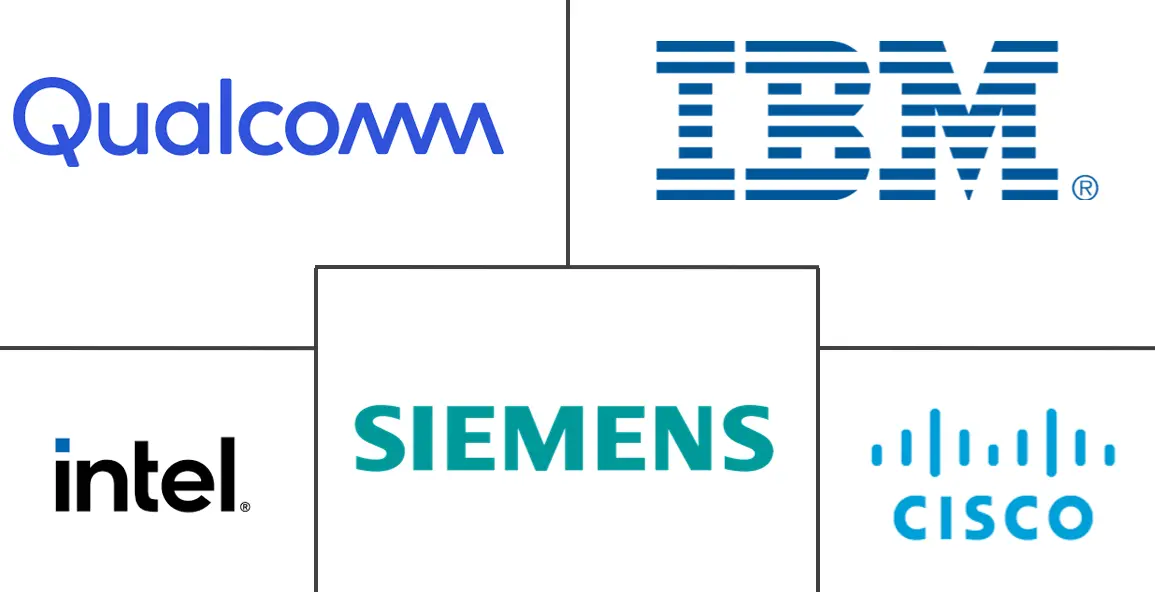Internet Of Nano Things Market Size and Share
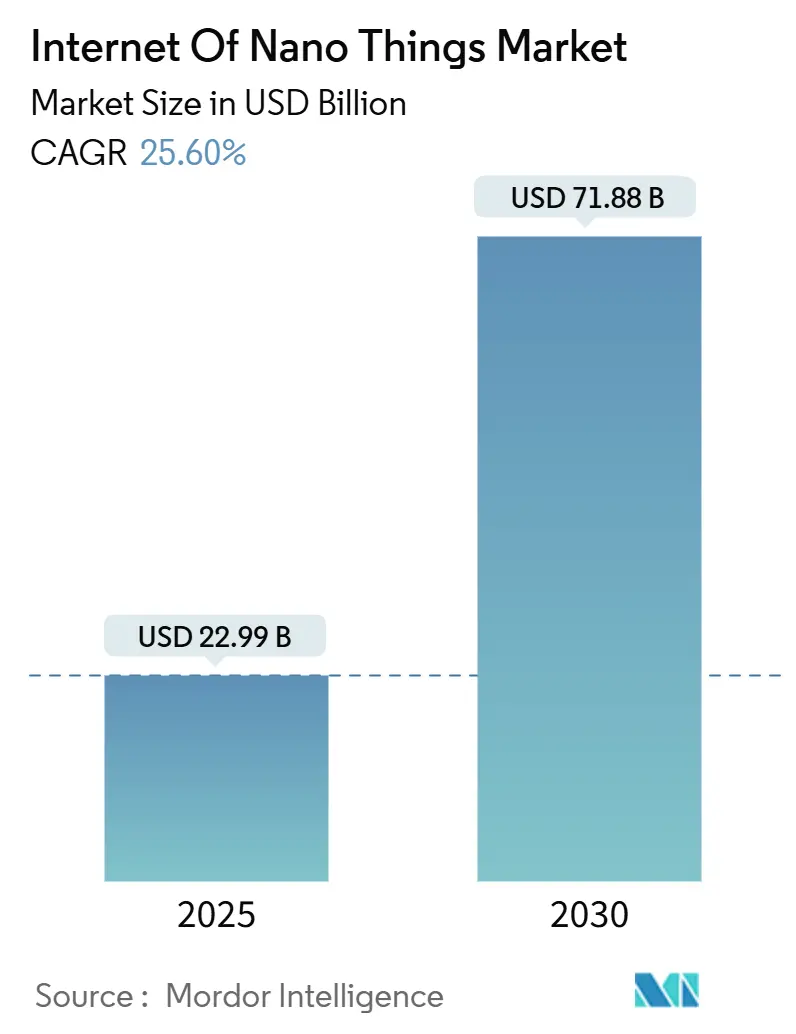
Internet Of Nano Things Market Analysis by Mordor Intelligence
The Internet of Nano Things Market size is estimated at USD 22.99 billion in 2025, and is expected to reach USD 71.88 billion by 2030, at a CAGR of 25.60% during the forecast period (2025-2030). The surge reflects the commercialisation of terahertz‐band nano-antenna designs, the roll-out of ultra-low power carbon-nanotube sensors, and the rapid convergence of nanoscale communication protocols with mainstream wireless networks. Governments are funding pandemic surveillance frameworks built on nanosensors, while private investment is accelerating AI-driven orchestration platforms that translate molecular-level data into actionable insight. Hardware continues to account for almost half of all spending, but software platforms are expanding at a markedly faster pace as enterprises prioritise analytics over devices. Regionally, North America leads on account of federal research grants and early terahertz spectrum allocation, yet Asia-Pacific exhibits the strongest growth as semiconductor hubs embed nanosensor networks into Industry 4.0 roadmaps. Competitive pressure is intensifying as semiconductor majors leverage existing fabs while start-ups introduce disruptive molecular communication stacks, but steep fabrication costs and fragmented spectrum policies remain notable headwinds.
Key Report Takeaways
- By component, hardware dominated with 47.6% of the Internet of Nano Things market share in 2024, whereas software is projected to post a 28.6% CAGR to 2030.
- By end-user, healthcare held 30.3% revenue share in 2024; smart cities and infrastructure are forecast to expand at a 27.6% CAGR through 2030.
- By communication technology, nano sensor networks captured 33.1% of the Internet of Nano Things market size in 2024, and molecular communication will grow the fastest at 28.4% CAGR to 2030.
- By deployment model, cloud solutions commanded a 54.6% share of the Internet of Nano Things market size in 2024, while hybrid architectures should record a 29% CAGR to 2030.
- By geography, North America led with 38.6% of the Internet of Nano Things market share in 2024; Asia-Pacific is projected to be the fastest-growing region at 28.1% CAGR.
Global Internet Of Nano Things Market Trends and Insights
Drivers Impact Analysis
| Driver | ( ~ ) % Impact on CAGR Forecast | Geographic Relevance | Impact Timeline |
|---|---|---|---|
| Rapid advancements in nanotechnology enabling ultra-low power sensors | +6.2% | Global, with concentration in North America and Asia-Pacific | Medium term (2-4 years) |
| Growing demand for real-time health monitoring wearables | +5.8% | Global, led by North America and Europe | Short term (≤ 2 years) |
| Increasing adoption of Industry 4.0 and smart manufacturing | +4.9% | Asia-Pacific core, spill-over to North America and Europe | Medium term (2-4 years) |
| Proliferation of 5G/6G and edge computing infrastructure | +4.1% | Global, with early deployment in developed markets | Long term (≥ 4 years) |
| Emerging terahertz-band nano-antenna breakthroughs reducing signal attenuation | +3.7% | North America and Europe, expanding to Asia-Pacific | Long term (≥ 4 years) |
| Government-funded pandemic surveillance networks leveraging nanosensors | +2.1% | Global, with government-led initiatives | Short term (≤ 2 years) |
| Source: Mordor Intelligence | |||
Rapid Advancements in Nanotechnology Enabling Ultra-Low Power Sensors
Carbon-nanotube-based devices now harvest ambient energy, removing conventional battery constraints and slashing maintenance cycles. MIT engineers demonstrated plant-powered nanosensors that self-energize through photosynthesis, validating energy autonomy for remote deployments. [1]Matt Sparks, “Plant-Based Nanosensors Harvest Energy From Photosynthesis,” technologyreview.com Boron nitride nanotube fibres provide heat-tolerant networks that withstand harsh industrial settings without degradation. Coupled with AI-accelerated materials discovery, exemplified by Materials Nexus’ rare-earth-free permanent magnet breakthrough, innovation cycles have shrunk from years to months. These advances unlock applications ranging from precision agriculture to hazardous-environment monitoring, underpinning the long-term growth of the Internet of Nano Things market.
Growing Demand for Real-Time Health Monitoring Wearables
FDA clearance of Nanowear’s nanosensor cardiac patch underscores regulatory validation for nano-enabled medical devices. [2]Source: US Food and Drug Administration, “510(k) Clearance Database,” fda.gov Continuous glucose monitors built on carbon-nanotube films now rival laboratory accuracy while retaining discreet, skin-patch form factors. Multi-analyte patches track electrolytes, lactate, and cortisol simultaneously, supporting preventive care models that lower chronic-disease costs. Hospitals integrating these devices report earlier sepsis detection and shorter ICU stays, reinforcing healthcare’s contribution to the Internet of Nano Things market expansion. The sector’s 30.3% revenue share in 2024 signals entrenched demand that other verticals must challenge.
Increasing Adoption of Industry 4.0 and Smart Manufacturing
Manufacturers embed nanosensors in capital assets to capture molecular-scale friction signatures, enabling prediction of bearing failures weeks ahead; Nanoprecise clients report up to 70% reductions in unplanned downtime. TSMC employs nanosensor grids inside fabs to detect sub-nanometre particle contamination, safeguarding yield at advanced nodes. Molecular communication protocols create self-organising sensor swarms that adapt to shifting production schedules without manual re-programming. These capabilities improve overall equipment effectiveness by as much as 25% and underpin the 4.9% positive CAGR contribution attributed to smart-manufacturing adoption.
Proliferation of 5G/6G and Edge Computing Infrastructure
5G roll-outs offer sub-10 ms latency, a baseline for real-time nanosensor feedback loops. Emerging 6G concepts allocate terahertz bands specifically for nano-device traffic, eliminating antenna-size constraints and enabling direct device-to-device exchanges. Qualcomm’s multi-link management patents target extended-reality workloads powered by distributed nanosensor arrays. At the edge, customised inference chips process molecular data locally, cutting response times to microseconds. The infrastructure evolution is especially critical for autonomous robots and hazard-detection systems, where latency gaps risk operational safety.
Restraints Impact Analysis
| Restraint | (~) % Impact on CAGR Forecast | Geographic Relevance | Impact Timeline |
|---|---|---|---|
| Severe data security and privacy risks at nanoscale | -4.3% | Global, with heightened concerns in Europe and North America | Short term (≤ 2 years) |
| High capital costs and complexity of nano-fabrication | -3.8% | Global, particularly affecting emerging markets | Medium term (2-4 years) |
| Biocompatibility and long-term cytotoxicity concerns in human body deployments | -2.1% | Global, with stricter regulations in developed markets | Long term (≥ 4 years) |
| Lack of standardized terahertz spectrum regulations causing deployment delays | -1.9% | Global, with regional variations in regulatory frameworks | Medium term (2-4 years) |
| Source: Mordor Intelligence | |||
Severe Data Security and Privacy Risks at Nanoscale
Nanosensors lack the compute headroom for traditional encryption, exposing attack surfaces that could compromise hospital, factory, or municipal networks. Implantable medical nanosensors are especially vulnerable; a hijacked glucose monitor can falsify readings, endangering patients. GDPR treats nanosensor data as high-risk, mandating explicit consent that is difficult to implement on autonomous sub-millimetre devices. Quantum-resistant lightweight ciphers remain at proof-of-concept stages, widening the security gap and exerting a negative 4.3% pull on forecast CAGR for the Internet of Nano Things market.
High Capital Costs and Complexity of Nano-Fabrication
State-of-the-art nano fabs exceed USD 1 billion in upfront investment, with yields hampered by defect density above 30%. Entegris generated USD 773 million in Q1 2025 sales from contamination-control tools that are now indispensable for nanosensor production. Skilled-labour shortages extend equipment ramp-up to 24 months, stretching payback periods and restraining supply. Consequently, smaller entrants rely on foundry partnerships or focus on design IP, tempering competitive diversity despite strong end-market demand.
Segment Analysis
By Component: Software Acceleration Outpaces Hardware Dominance
Hardware generated 47.6% of 2024 revenue, anchoring the Internet of Nano Things market in essential physical devices, antennas, and gateways. Yet the software segment is racing ahead at a 28.6% CAGR as analytics platforms capitalise on torrents of molecular data. Services remain nascent but record double-digit growth because enterprises require consulting expertise to integrate nano-devices with legacy systems. Dow’s collaboration with Carbice on thermal interface materials shows how specialised know-how is turning into high-margin service lines. [3]Dow, “Partnership With Carbice,” dow.com
The software boom is redefining value capture: hardware margins compress as commoditisation sets in, while orchestration stacks that manage billions of endpoints command premium licences. Cloud vendors embed nano-device APIs, drawing developers into unified platforms that bundle security, AI, and lifecycle management. Over the forecast horizon, the Internet of Nano Things market size linked to software revenues is projected to narrow the gap on hardware, recalibrating competitive strategies across the ecosystem.
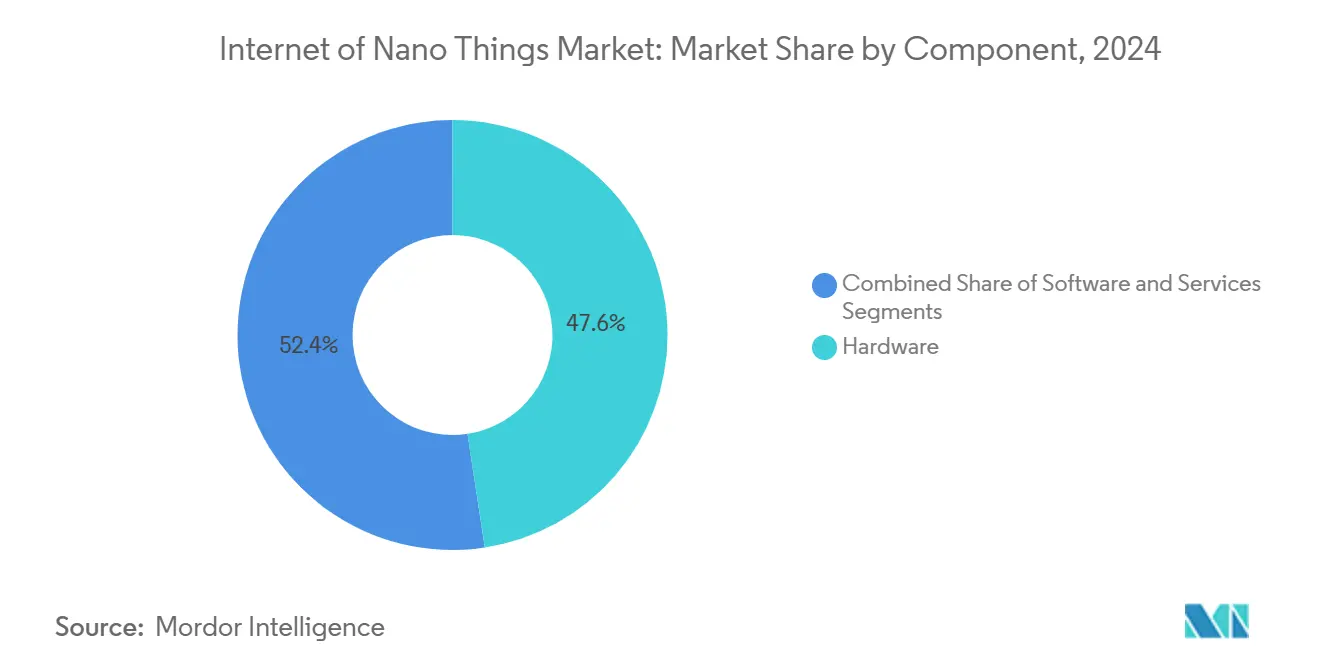
Note: Segment shares of all individual segments available upon report purchase
By End-user: Healthcare Leadership Challenged by Smart Cities Surge
Healthcare contributed 30.3% of 2024 revenue and remains the largest adopter, leveraging nanosensors for continuous vitals monitoring, implant surveillance, and smart drug delivery. Smart-city programmes, however, will expand at 27.6% CAGR to 2030 as municipalities deploy nanosensor meshes for air-quality analytics, water-leak detection, and intelligent traffic control. In manufacturing, nanosensors embedded on production lines feed real-time molecular data into predictive-maintenance engines, while logistics firms fit nanosensors inside containers to verify cold-chain compliance.
Environmental agencies adopt nanosensor buoys that detect pollutants at parts-per-billion resolution, a capability classical sensors lack. Agriculture outfits scatter plant-tissue nanosensors that signal nutrient deficits early, cutting fertiliser usage and water waste. These deployments illustrate how vertical diversification is accelerating overall Internet of Nano Things market penetration across the real economy.
By Communication Technology: Molecular Communication Disrupts Traditional Protocols
Nano sensor networks led with a 33.1% share in 2024, adapting classical RF protocols for pico-watt budgets. Molecular communication, though still emergent, will post a 28.4% CAGR to 2030 as biochemical signalling overcomes RF propagation limits inside human tissue or subterranean infrastructure. Electromagnetic links retain primacy where bandwidth demands are high, notably in industrial automation and smart grids. Passive Nano RFID tags support asset tracking, whereas nano satellite gateways offer global backhaul for environmental deployments.
Hybrid multi-radio chips dynamically toggle between terahertz, molecular, and RFID pathways, selecting the lowest-energy route based on context. Samsung’s AI-enabled scheduler evidences the trend toward orchestrated multi-modal stacks that underpin the Internet of Nano Things market expansion.
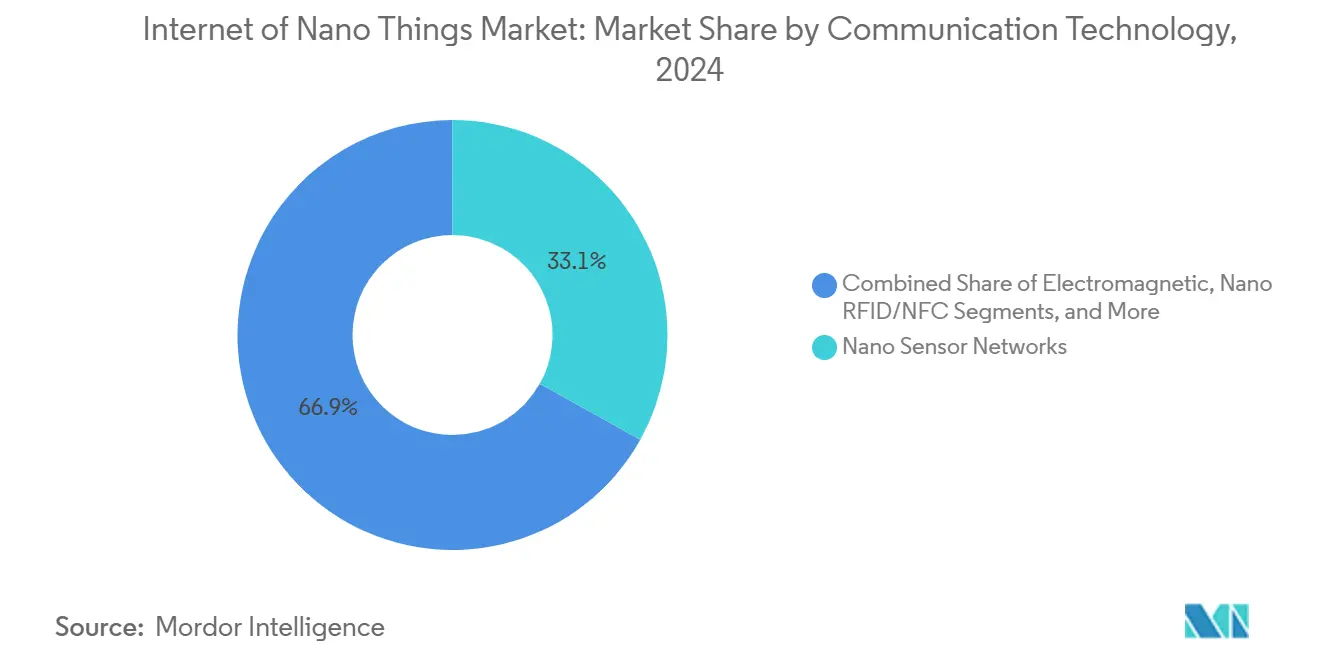
Note: Segment shares of all individual segments available upon report purchase
By Deployment Model: Hybrid Architectures Bridge Cloud-Edge Divide
Cloud platforms owned 54.6% of 2024 spending because nanosensor traffic requires elastic compute and large-scale analytics. Yet hybrid models will grow fastest at 29% CAGR as firms localise time-critical inference near machines and send aggregated insight to the cloud. AWS and Orbital Materials are co-designing AI workloads for greener data centres, reflecting pressure to host nano workloads sustainably.
On-premise variants serve defence, healthcare, and regulated industries that cannot offload sensitive molecular data to public clouds. Edge boxes integrate tamper-resistant modules and quantum-safe ciphers, addressing privacy worries highlighted earlier. Over time, reference architectures will standardise workload placement, giving enterprises blueprints to scale Internet of Nano Things market deployments without breaching latency or sovereignty thresholds.
Geography Analysis
North America retained 38.6% revenue share in 2024, buoyed by federal grants, early terahertz spectrum allocation, and entrenched semiconductor fabs capable of nano-class production. The NIST IoT Advisory Board provides clarity around standards, accelerating commercial pilots. However, high labour costs and capital outlays squeeze margins, and the talent pipeline struggles to supply nano-manufacturing technicians. The United States focuses on defence, aerospace, and advanced healthcare implants, while Canada channels resources into environmental monitoring for natural-resource stewardship.
Asia-Pacific will post a 28.1% CAGR to 2030, reflecting aggressive Industry 4.0 incentives, deep electronics supply chains, and expansive 5G footprints. China drives manufacturing uptake, embedding nanosensors inside fabs and chemical plants to boost yield and safety, while Japan’s med-tech firms pioneer bio-compatible nano implants. South Korea exploits telecom leadership to pilot 6G-ready nano-mesh networks. Regional governments subsidise nano R&D, compressing time-to-market and intensifying competition. The resulting scale advantages will narrow the Internet of Nano Things market size gap between Asia-Pacific and North America by decade end.
Europe remains influential, championing data privacy and sustainability frameworks that shape global norms. Horizon Europe has earmarked EUR 100 million for edge-AI and IoT research, with part allocated to nano-device interoperability. Germany deploys nanosensors in precision manufacturing, and the United Kingdom tests graphene-based health patches. Emerging regions in South America and the Middle East, and Africa invest selectively in environmental and infrastructure monitoring, capitalising on nanosensors’ ability to deliver high granularity at lower lifecycle costs.
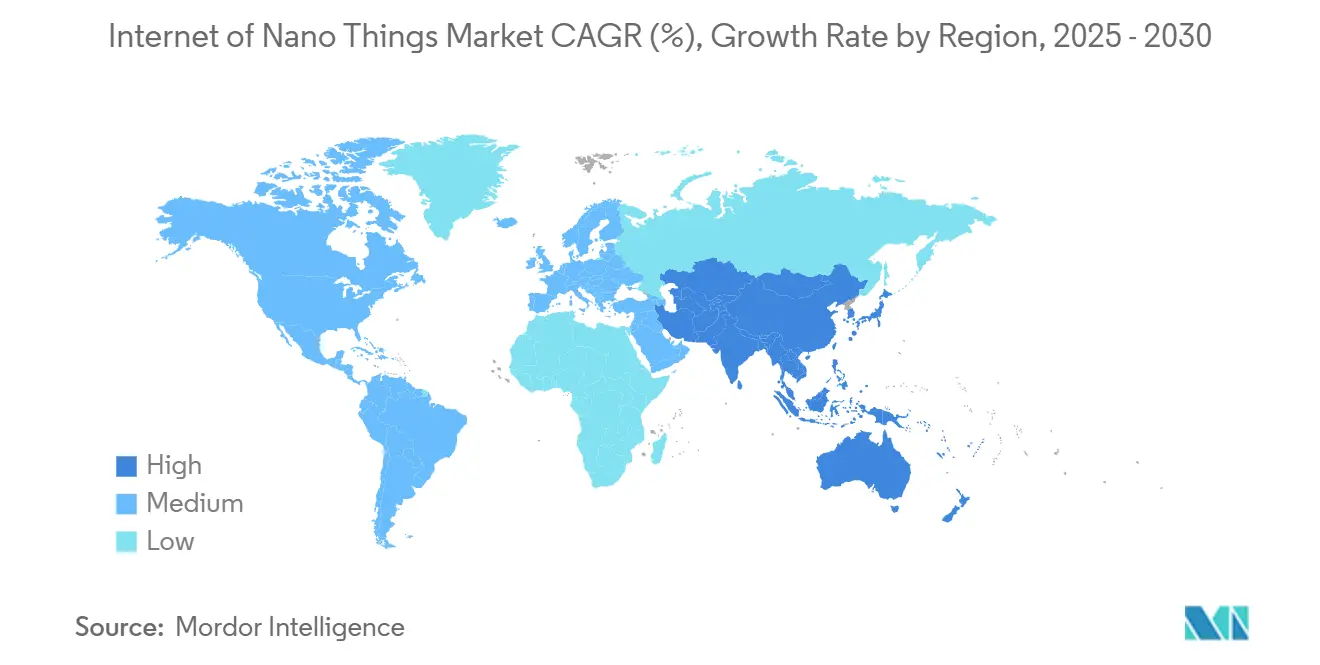
Competitive Landscape
The Internet of Nano Things market is moderately fragmented: top semiconductor houses such as Intel, Samsung, and STMicroelectronics leverage billion-dollar fabs, while start-ups like Nanoscribe and Nanoprecise specialise in photonic nanoprinting and predictive-maintenance sensors. The race centres on material innovations, AI-enabled orchestration, and vertical integration. Seoul National University’s patent for a scalable nano computing device underscores academic contributions that incubate commercial breakthroughs. [4]Seoul National University R&DB Foundation, “Nano Computing Device Patent Application,” uspto.report
Strategic alliances are common. 3M joined the US-JOINT consortium to pool R&D on advanced packaging, strengthening die-stacking know-how critical for nanosensor modules. Dow and Carbice merged silicone chemistry with carbon-nanotube thermal interfaces, solving heat issues that limit sensor density. Tool vendors Veeco and Lam Research enjoy backlog growth as deposition and etch intensity rise for nano-scale geometries. Meanwhile, materials specialist Materials Nexus unveiled rare-earth-free magnets, signalling a drive to lower bill-of-materials costs and diversify supply risk.
Regulation shapes strategy. Firms with early compliance with GDPR-class privacy and terahertz spectrum guidelines secure procurement advantages. Start-ups often license IP to incumbents instead of scaling capex-heavy manufacturing, fostering a layered ecosystem of device OEMs, foundries and software orchestrators. This dynamic balances innovation velocity with supply-chain resilience as the Internet of Nano Things market matures.
Internet Of Nano Things Industry Leaders
-
IBM Corporation
-
Intel Corporation
-
Cisco Systems, Inc.
-
Qualcomm Technologies, Inc.
-
Siemens AG
- *Disclaimer: Major Players sorted in no particular order
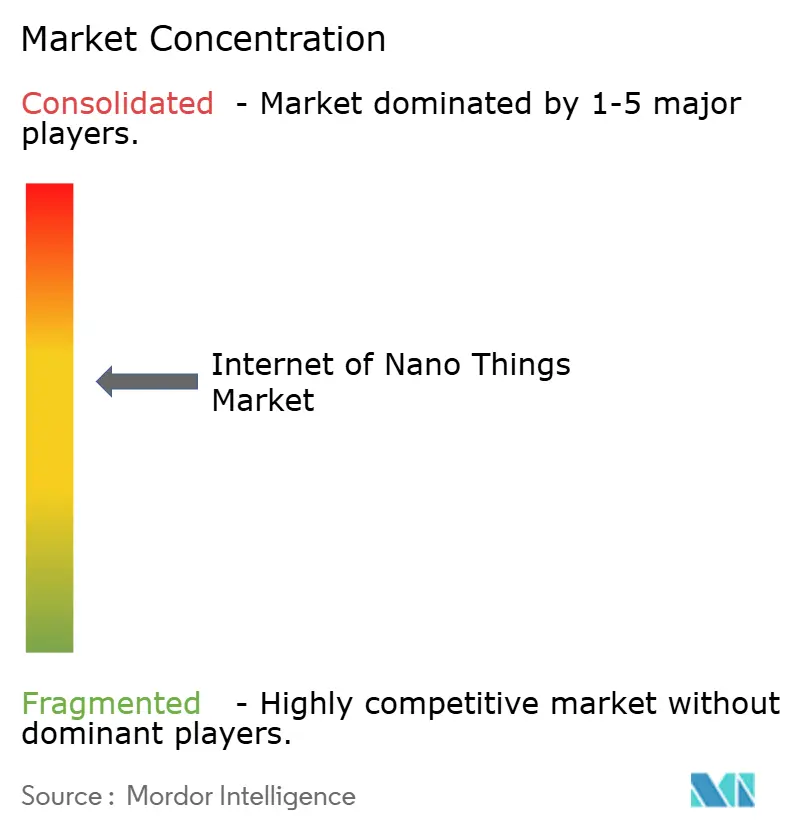


Recent Industry Developments
- May 2025: Veeco Instruments posted USD 167.3 million Q1 2025 revenue and won Intel’s EPIC supplier award.
- May 2025: Entegris recorded USD 773 million Q1 2025 sales, underscoring demand for contamination-control consumables vital to nano-fab output.
- April 2025: Lam Research reported 8% revenue growth to USD 4.72 billion on higher deposition and etch demand.
- February 2025: 3M joined the US-JOINT Consortium, a 12-member group advancing semiconductor packaging to support AI and high-performance nano devices.
- February 2025: Dow and Carbice announced a partnership to commercialise carbon-nanotube thermal interface materials for next-generation electronics.
- December 2024: Orbital Materials and AWS signed a multi-year agreement to co-develop AI solutions that reduce data-centre carbon footprints.
- October 2024: Versarien Plc expanded its graphene pipeline to GBP 4.7 million and secured a licensing deal with Montana Química for graphene production in Brazil.
Global Internet Of Nano Things Market Report Scope
The scope of the IoNT market study is structured to track spending on hardware, software, and connectivity services across industries such as healthcare, logistics, aerospace, manufacturing, retail, and energy power, among other end-user industries. All data presented in the study is as per the most recent information, and all market projections are adjusted to reflect the impact of COVID-19 on the IoNT market.
The internet of nano things market is segmented by component (hardware, software, and connectivity/services), end-user (healthcare, logistics, defense and aerospace, manufacturing, energy and power, and retail), and geography (North America, Europe, Asia-Pacific, Latin America, and Middle East and Africa). The market sizes and forecasts are provided in terms of value (USD) for all the above segments.
| Hardware |
| Software |
| Services |
| Healthcare |
| Logistics and Transportation |
| Defense and Aerospace |
| Manufacturing |
| Energy and Power |
| Environmental Monitoring |
| Retail |
| Agriculture |
| Smart Cities and Infrastructure |
| Other End-users |
| Electromagnetic |
| Molecular Communication |
| Nano RFID/NFC |
| Nano Sensor Networks |
| Nano Satellite Communication |
| Others |
| On-Premise |
| Cloud |
| Hybrid |
| North America | United States | |
| Canada | ||
| Mexico | ||
| South America | Brazil | |
| Argentina | ||
| Chile | ||
| Rest of South America | ||
| Europe | Germany | |
| United Kingdom | ||
| France | ||
| Italy | ||
| Spain | ||
| Russia | ||
| Rest of Europe | ||
| Asia-Pacific | China | |
| India | ||
| Japan | ||
| South Korea | ||
| Singapore | ||
| Malaysia | ||
| Australia | ||
| Rest of Asia-Pacific | ||
| Middle East and Africa | Middle East | United Arab Emirates |
| Saudi Arabia | ||
| Turkey | ||
| Rest of Middle East | ||
| Africa | South Africa | |
| Nigeria | ||
| Egypt | ||
| Rest of Africa | ||
| By Component | Hardware | ||
| Software | |||
| Services | |||
| By End-user | Healthcare | ||
| Logistics and Transportation | |||
| Defense and Aerospace | |||
| Manufacturing | |||
| Energy and Power | |||
| Environmental Monitoring | |||
| Retail | |||
| Agriculture | |||
| Smart Cities and Infrastructure | |||
| Other End-users | |||
| By Communication Technology | Electromagnetic | ||
| Molecular Communication | |||
| Nano RFID/NFC | |||
| Nano Sensor Networks | |||
| Nano Satellite Communication | |||
| Others | |||
| By Deployment Model | On-Premise | ||
| Cloud | |||
| Hybrid | |||
| By Geography | North America | United States | |
| Canada | |||
| Mexico | |||
| South America | Brazil | ||
| Argentina | |||
| Chile | |||
| Rest of South America | |||
| Europe | Germany | ||
| United Kingdom | |||
| France | |||
| Italy | |||
| Spain | |||
| Russia | |||
| Rest of Europe | |||
| Asia-Pacific | China | ||
| India | |||
| Japan | |||
| South Korea | |||
| Singapore | |||
| Malaysia | |||
| Australia | |||
| Rest of Asia-Pacific | |||
| Middle East and Africa | Middle East | United Arab Emirates | |
| Saudi Arabia | |||
| Turkey | |||
| Rest of Middle East | |||
| Africa | South Africa | ||
| Nigeria | |||
| Egypt | |||
| Rest of Africa | |||


Key Questions Answered in the Report
How big is the Internet Of Nano Things Market?
The Internet Of Nano Things Market size is expected to reach USD 31.82 billion in 2025 and grow at a CAGR of 20.23% to reach USD 79.95 billion by 2030.
What is the current value of the Internet of Nano Things market?
The market generated USD 22.99 billion in 2025 and is forecast to reach USD 71.88 billion by 2030.
Which segment is growing fastest within the Internet of Nano Things market?
Smart cities and infrastructure lead growth, advancing at a projected 27.6% CAGR through 2030.
Why are hybrid deployment models gaining traction?
They balance the need for real-time edge processing with cloud-based analytics, delivering low latency while meeting data-sovereignty rules.
Which region will see the highest growth?
Asia-Pacific is expected to expand at 28.1% CAGR due to strong Industry 4.0 investment and robust 5G infrastructure.
What is the primary security challenge for nanosensor networks?
Resource-constrained devices struggle to run robust encryption, exposing them to data-privacy and cyber-attack risks.
How are material innovations influencing the market?
Breakthroughs such as rare-earth-free magnets and carbon-nanotube thermal interfaces reduce cost and improve performance, accelerating commercial adoption in multiple sectors.
Page last updated on:
